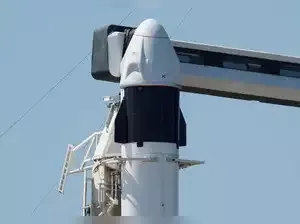Elon Musk's SpaceX launched a crew of four private astronauts led by a crypto entrepreneur on a mission to orbit Earth from pole to pole, a novel trajectory in which no humans have travelled before.
Maltese investor Chun Wang, a Chinese-born magnate who founded a bitcoin mining company, is the bankroller and commander of the SpaceX mission, named Fram2, a reference to the Norwegian "Fram" ship that pioneered Arctic exploration at the turn of the 20th century.
The four crew members on Monday afternoon were driven to the launchpad in a caravan of Teslas - the electric cars of Musk's other company - winding through the roads of Cape Canaveral, Florida, with a police escort, as a SpaceX Falcon 9 rocket launched overhead in an unrelated Starlink mission.
Who are part of the spacecraft?
What is Fram2?
Fram2 will be the 16th crewed mission overall using the reusable Crew Dragon, a gumdrop-shaped spacecraft that SpaceX developed with NASA funding to provide the U.S. space agency a ride for its astronauts to and from the International Space Station. SpaceX and its Dragon craft have dominated the nascent market for private orbital spaceflight, an area in which a key source of demand originally came from a small field of wealthy tourists. Dragon is the world's only privately built capsule routinely flying missions in orbit, as Boeing's Starliner capsule is held up in development.
In recent years, with Dragon flights costing roughly $55 million per seat, the spaceflight market - involving companies such as Axiom Space that contract Crew Dragon missions - has fixated more on astronauts from governments willing to pay the sum mainly for national prestige and bolstering domestic spaceflight experience.
The crew plans two dozen experiments — including taking the first human X-rays in space — and brought along more cameras than usual to document their journey called Fram2 after the Norwegian polar research ship from more than a century ago.
Until now, no space traveller had ventured beyond 65 degrees north and south latitude, just shy of the Arctic and Antarctic circles. The first woman in space, the Soviet Union’s Valentina Tereshkova, set that mark in 1963. Yuri Gagarin, the first man in space, and other pioneering cosmonauts came almost as close, as did NASA shuttle astronauts in 1990.
A polar orbit is ideal for climate and Earth-mapping satellites as well as spy satellites. That’s because a spacecraft can observe the entire world each day, circling Earth from pole to pole as it rotates below.
Wang pitched the idea of a polar flight to SpaceX in 2023, two years after US tech entrepreneur Jared Isaacman made the first of two chartered flights with Musk’s company. Isaacman is now in the running for NASA’s top job.
SpaceX's Kiko Dontchev said late last week that the company is continually refining its training so “normal people” without traditional aerospace backgrounds can “hop in a capsule ... and be calm about it.”
Maltese investor Chun Wang, a Chinese-born magnate who founded a bitcoin mining company, is the bankroller and commander of the SpaceX mission, named Fram2, a reference to the Norwegian "Fram" ship that pioneered Arctic exploration at the turn of the 20th century.
The four crew members on Monday afternoon were driven to the launchpad in a caravan of Teslas - the electric cars of Musk's other company - winding through the roads of Cape Canaveral, Florida, with a police escort, as a SpaceX Falcon 9 rocket launched overhead in an unrelated Starlink mission.
Who are part of the spacecraft?
- Maltese investor Chun Wang
- Norwegian film director Jannicke Mikkelsen
- German robotics researcher
- Polar scientist Rabea Rogge
- Australian adventurer Eric Philips
What is Fram2?
Fram2 will be the 16th crewed mission overall using the reusable Crew Dragon, a gumdrop-shaped spacecraft that SpaceX developed with NASA funding to provide the U.S. space agency a ride for its astronauts to and from the International Space Station. SpaceX and its Dragon craft have dominated the nascent market for private orbital spaceflight, an area in which a key source of demand originally came from a small field of wealthy tourists. Dragon is the world's only privately built capsule routinely flying missions in orbit, as Boeing's Starliner capsule is held up in development.In recent years, with Dragon flights costing roughly $55 million per seat, the spaceflight market - involving companies such as Axiom Space that contract Crew Dragon missions - has fixated more on astronauts from governments willing to pay the sum mainly for national prestige and bolstering domestic spaceflight experience.
What does the exploration include?
The crew plans two dozen experiments — including taking the first human X-rays in space — and brought along more cameras than usual to document their journey called Fram2 after the Norwegian polar research ship from more than a century ago.
Until now, no space traveller had ventured beyond 65 degrees north and south latitude, just shy of the Arctic and Antarctic circles. The first woman in space, the Soviet Union’s Valentina Tereshkova, set that mark in 1963. Yuri Gagarin, the first man in space, and other pioneering cosmonauts came almost as close, as did NASA shuttle astronauts in 1990.
A polar orbit is ideal for climate and Earth-mapping satellites as well as spy satellites. That’s because a spacecraft can observe the entire world each day, circling Earth from pole to pole as it rotates below.
Wang pitched the idea of a polar flight to SpaceX in 2023, two years after US tech entrepreneur Jared Isaacman made the first of two chartered flights with Musk’s company. Isaacman is now in the running for NASA’s top job.
SpaceX's Kiko Dontchev said late last week that the company is continually refining its training so “normal people” without traditional aerospace backgrounds can “hop in a capsule ... and be calm about it.”








